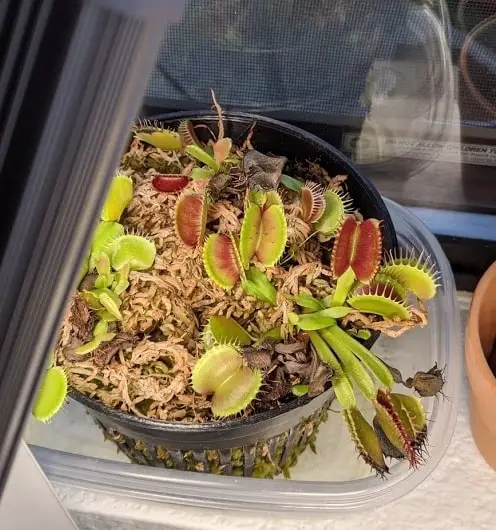People grow Venus flytraps all over the world, as these plants are resilient and can adapt to different climates. Still, some locations are better suited for growing Venus flytraps. This article will cover all the details of how to grow Venus flytraps in Texas.
The state of Texas is a suitable location to grow Venus flytraps. Venus flytraps can thrive growing in Texas with over 200 sunny or partially sunny days and average humidity of 64.9%. Not all cities in Texas provide cool weather for dormancy, but artificially-induced dormancy is an option.
You can grow Venus flytraps in Texas, but you will benefit from learning some specific care tips for the region. This article will guide you through all you need to know when growing Venus flytraps in Texas.
Can Venus Flytraps Grow in Texas?
Venus flytraps are native to a tiny region. They grow naturally only in the states of North Carolina and South Carolina in the United States.
Venus flytraps do not grow naturally in Texas. However, due to the appropriate growing conditions, it is possible to grow Venus flytraps in homes and gardens in most cities in Texas.
Venus flytraps require lots of sun and water to survive. They benefit from high exposure to humidity, and during their growing season, they should optimally receive at least 6 hours of sunlight.
In Texas, the majority of cities have over 100 sunny days and 100 partially sunny days. With that amount of natural lights, Venus flytraps can be grown outdoors without any issues.
The high humidity in the state of Texas is an important factor to consider when growing Venus flytraps. Venus flytraps can adapt to dry climates, but they prefer a humid environment. Humidity above 50% is optimal for Venus flytraps.
In terms of temperature, Texas provides a wide range of temperatures between summers and winter. But, the temperature spread is not an issue for Venus flytraps. These plants can comfortably live between 32 F and 95 F (0 C – 35 C).
How Do You Take Care of a Venus Fly Trap in Texas?
In this section, I will teach you how to take care of Venus flytraps in Texas. Since there are many highly populated cities within the state, I will give you some examples of temperature ranges for outdoor plant placement and dormancy for specific cities.
Watering and Humidity for Venus Flytraps
Venus flytraps require plenty of water to survive. They need to be water continuously as they like to grow in humid environments.
Texas provides high humidity, which is beneficial for Venus flytraps. But, the plants still need to be watered often.
When watering Venus flytraps, water until the soil is humid but not soaked or flooded. Then, wait until it is less humid to water again. Also, Venus flytraps can only be water with very particular sources.
Never water Venus flytraps with tap water or bottled water. The minerals within the water can kill Venus flytraps. Instead, employ any of the following water sources:
- Distilled water
- Reverse osmosis water
- Rainwater
Appropriate Lighting for Venus Flytraps
In the wild, Venus flytraps live in very sunny areas. They require exposure to several hours of light every day to survive.
With the high number of sunny and partially sunny days in most Texas cities, it is recommended to grow Venus flytraps outdoors where the plant can have access to sunlight.
Venus flytraps require at least 6 hours of light a day. Optimally, they should receive 12 hours of light. The light source can be natural light or artificial lights such as LEDs or fluorescent lights.
Depending on the exact location of your home, you must find a good placement for your plant. Sunny window sills and porches tend to be a good location. Also, open gardens with access to lots of sun are suitable placement options.
Growing Venus flytraps indoors is possible, but you must ensure the plants have access to enough light. You can grow Venus flytraps indoors under artificial light or a combination of natural light and artificial lighting.
T8 bulbs are good fluorescent light options. Also, they are inexpensive. I have employed this small LED plant light (which cost me less than $30) to grow 3 Venus flytraps, and they are growing strong. You can follow the link to check the current price on Amazon.

Venus Flytrap Temperature Needs (with examples in Texas)
The table below lists the average temperature ranges during winter and summer for several cities in Texas.
| Summer Temperature Ranges | Winter Temperature Ranges | |
| Houston | 74 F – 91 F | 45 F – 63 F |
| San Antonio | 72 F – 96 F | 40 F – 67 F |
| Dallas | 73 F – 96 F | 37 F – 61 F |
| Austin | 72 F – 96 F | 41 F – 65 F |
| Fort Worth | 73 F – 97 F | 36 F- 63 F |
| El Paso | 69 F – 98 F | 33 F – 65 F |
| Arlington | 71 F – 95 F | 35 F – 61 F |
| Corpus Christi | 78 F – 90 F | 48 F – 67 F |
| Amarillo | 61 F – 92 F | 23 F – 54 F |
Venus flytraps can be grown almost anywhere globally because they withstand a wide range of temperatures. Venus flytraps can live comfortably within 32 F and 95 F (0 C – 35 C).
As you can see in the table above, most cities’ temperatures fall between the acceptable ranges for Venus flytraps. Some summer temperatures are slightly hotter than the recommended. However, this is not a major issue.
When temperatures start reaching the high 90s, I recommend to move the plant to partial shade and continue to water consistently. You could also bring the plant indoors, but this is not usually necessary.
Regarding cold temperatures, the main issue tends to be freezing. You should never let your Venus flytrap freeze solid; it might not recover. During winter, Venus flytraps prefer colder weather, which they can get in most of the cities from the table. The only city where you should worry about freezing temperatures is Amarillo.
Venus Flytrap Dormancy in Texas
Venus flytrap dormancy is a challenge when growing Venus flytraps in Texas.
Venus flytraps require a dormancy period. Dormancy is very similar to hibernation. During the winter, the plant goes to sleep for several months, it stops growing, and most of its leaves wither. After dormancy is over, the Venus flytrap comes back to life, growing new leaves and flourishing.
The dormancy period is critical for Venus flytraps. With a yearly dormancy, Venus flytraps can live for several decades. But without dormancy, their lifespan shortens significantly. If a plant skips dormancy multiple years in a row, the plant dies.
To achieve dormancy, Venus flytraps need to be exposed to temperatures below 45 F (7 C) for several weeks. Then the plant must continue to be exposed to low temperatures for at least 2-3 months. During this period, the plant will be dormant.
Once the temperatures start rising, Venus flytraps will slowly exit dormancy.
In Texas, most cities do not provide a consistently cold winter to induce natural dormancy for Venus flytraps. Do some research beforehand, and check if there is any possibility your plant could go dormant outdoors, in a cold basement, or perhaps an unheated garage. If the temperatures are not cold enough for dormancy, you should consider an alternate option.
In those locations where it is impossible to induce natural dormancy, you can employ Refridgerator Dormancy. As a last resort, it is possible to induce dormancy by placing Venus flytraps in the fridge. There are certain steps you need to follow to complete this process. You can watch this video to learn the details:
Employing Terrariums for Venus Flytraps
Many people grow Venus flytraps in terrariums to provide a humid environment. You won’t need to employ any terrarium, as the climate is already humid in Texas.
Sometimes, when growing Venus flytraps indoors, in an airconditioned location, humidity can lower. In those scenarios, I still do not recommend a terrarium to increase the humidity. The best option is to buy a humidifier and consistently employ the humidifier where the plant is located.
Other Venus Flytrap Care Considerations
This is a list of other items to consider when growing Venus flytraps. They are not specific for growing Venus flytraps in Texas, but definitely worth mentioning.
- Soil: Only employ nutrient-free soil. Pure sphagnum moss or peat moss are viable options.
- Feeding: Access to bus promotes growth. But feeding a Venus flytrap is not required.
- Pot Dimensions: Choose deep pots (7 inches in depth) that match the plant’s size: 2 inches – 6 inches in diameter.
- Pot Materials: Plastic, Styrofoam, and glazed ceramic are suitable options.
- Repotting:Repot Venus flytraps once a year (here is a guide on how to pot your plants).
- Trimming: Remove black leaves by trimming them with scissors.
- Fertilizers: Do not fertilize Venus flytraps.
Final Thoughts
I have seen people grow Venus flytraps in many different locations. Texas is not the most perfect location to grow Venus flytraps due to their lack of consistently cold winters. But it does provide a suitable environment with lots of sunlight and humidity. As long as you can fulfill the dormancy requirements, I see no reason why growing Venus flytraps in Texas would be a challenge.
Growing Venus flytraps is a rewarding experience, but it can be difficult due to their very particular requirements. This article outlines all you need to know about Venus Flytrap Care. I hope it can help you grow healthy Venus flytraps. Best of luck!


